Rajpreet Kaur
Rayat and Bahra Institute of Management, Bohan 146001, Hoshiarpur (Punjab), India
Correspondence to: Rajpreet Kaur, Rayat and Bahra Institute of Management, Bohan 146001, Hoshiarpur (Punjab), India.
| Email: |  |
Copyright © 2012 Scientific & Academic Publishing. All Rights Reserved.
Abstract
Managing talent in a global organization is more complex and demanding than it is in a national business and few major worldwide corporations have risen to the challenge. This paper focuses on highlighting the way in which the organizations should embrace talent management to obtain and retain the best talent available for the success of their organization. The objective of this paper is to analyze and retain the employees by managing their talent in Indian supermarket (Big Bazaar). The sample size has been taken as 220 out of total population of 500. This paper also accounts for the impacts of talent management program on employees. Additional calculations are also shown to understand that how much it helps to retain. From the analysis, it was found that almost all of the respondents are satisfied with the result of the talent management program. Almost all the employees agreed that the talent management program creating a good work culture as well as enhances the values of employees and decrease in turnover of employees. Final observations of the study are that most of the employees are satisfied that talent management program helps to identify the strength and weakness of employees.
Keywords:
Talent Management, Strategic Human Resources, Big Bazaar
Cite this paper: Rajpreet Kaur, Empirical Study of Talent Management Program and Its Impact on the Employee’s Retainment and Performance in Indian Supermarket Big Bazaar, Human Resource Management Research, Vol. 3 No. 3, 2013, pp. 61-70. doi: 10.5923/j.hrmr.20130303.01.
1. Introduction
Before going into the deeper discussion on Talent Management, it would be advantageous to understand the word “talent”. Talent generally refers to the capabilities, skills or the art of a particular person possess in a particular field. In other words, it refers to those people who have high potential even though they might have scarce knowledge and skills or who can successfully bring out transformation and change in the organization with the motto of “keeping people who keep you in business”. The word talent management in an organization was coined[1] by David Watkins of Softscape in 1998. It is defined as the process of attracting and retaining profitable employees. It also refers to those special steps an organization adopts to recruit, develop and retain its pool of top talent. The steps adopted should normally be creative and should not project bureaucracy. Talent Management also denotes a deliberate approach taken up by an organization to attract, develop and retain people with the aptitude and abilities to meet not only the current requirements but also future organizational need. It should be noted that talent management in this context does not refer to the management of entertainers. The current business and economic environment is exposing a host of weaknesses in the talent management practices of many organizations, as well as the lack of a comprehensive understanding of skills, capabilities, key workforces and top talent, etc. Talent management is the process of attracting, selecting, training, developing, and promoting employees throughout the institution. The primary focus of these practices is to obtaining and developing talent which ensures that staff has the necessary tools, support, and resources to perform the task in a well organized manner. It also ensures that they are properly motivated and compensated; and ready to transition into leadership roles as appropriate. Staff becomes valuable assets because, over time, they develop the necessary core competencies and internalize institutional core values. Talent management is also known as HCM (human capital management), HRIS (human resources information systems) or HRMS (human resources management systems), and HR Modules[2]. Organizations mainly focus on developing their talent by integrating the plans and processes to track and manage their employee’s talent. The following points[2] are generally considered during the integration process: (i) Sourcing, attracting and recruiting qualified candidates with competitive backgrounds, (ii) Overlook of competitive salaries, (iii) Professional development opportunities, (iv) Performance management processes, (v) Retention programs, and (vi) Promotion and transitioning, etc.Key[3] discussed that talent management helps supermarket chain live brand promise. Key[3] detailed that united supermarket’s learning and performance management strategies help the company increase employee engagement, maintain costumer loyalty and control the cost. Key[3] summarized as “We believed our growth and success are tied to our commitment to service. By aligning our talent management processes to support this commitment, and using the right technology solution, we are more capable than ever of living to our brand promise throughout the organization”. Keeping in the views of Key[3] and talent management practices, this paper focuses on highlighting the way in which the organizations should embrace talent management to obtain and retain the best talent available for the success of their organization. It accounts for the impacts of talent management program on employees. The broad objective of the study is to analyze the talent management program of big bazaar (one of the Indian supermarket) and its impact on the employees. Additional analysis has also been done to investigate the satisfaction of employees with TMP and theirs retaining strategies.
2. Importance of Talent Management Program in Organization
Talent management brings together a number of important human resources and management initiatives. Quite often, organizations adopting a talent management approach will focus on co-coordinating and integrating of the following strategies[4]: ● Recruitment - ensuring the right people are attracted and employed in the organization.● Retention - development and implementation practices that reward and support employees.●Professional development - ensuring continuous informal and formal learning and development.●Advanced leadership and development - specific development programs for existing and future leaders having strong potential toward the organization.● Performance management - specific processes that nurture and support performance, including feedback / measurement.● Workforce planning - planning for business and general changes, including the older workforce and current/future skills shortages.● Culture - development of a positive, progressive and high performance “way of operating”. An important step is to identify the staff or employees (people and positions) that are critical to the organization. They do not necessarily have to be senior staff members.With the help of the above detailed integration process as a part of the talent management program, organizations provide individuals the opportunity and space for physically manifesting their talent into performance for achieving individual and organizational vision. Talent manifests into performance as shown in Figure 1. Thus, in addition to the overall development of individual’s intrinsic capacities, the domain of talent management also focuses on better working environment and positive changes in the management to provide the other elements listed above for manifestation of talent into performance. In general, talent management programs (TMP) aims to accomplish the following[5,6]:● To provide a holistic view of the individual: current and future.● To help in identifying and preparing future leadership talent.● To provide key resources with recognition and growth opportunities.● To facilitate retention of high performers.● To help identify and groom potential development plans.● To complement the rewards system. | Figure 1. A pictorial representation of steps in conversion of talent to performance |
The supply side puts pressure on organization to attract the best talent and ensure that employees join the company and choose to stay in the organization rather than look for opportunities elsewhere. In the recent days, the human resources department of any organization is vested with the responsibility of managing the talent, in addition to its conventional function of providing good human capital to an organization. In order to perform this function, they use the following methods: 1. Identifying the suitable talent 2. Right selection of the talent3. Implementing competitive compensation plans4. Training and continuous development of competencies5. Practicing state-of-the–art performance appraisal systems6. Aligning the acquired talent7. Developing and nurturing the talent, and8. Retaining the talent
3. Background Review
Over the years, considerable research efforts have been put into the development and implementations of talent management program. The available literature reveals that organizations have focused on talent management and understood that talent management is aligned to the employees with the mission and vision of the organization which ends up with better results to their organizations. A voluminous body of information has emerged in the literature (journal articles, text books, handbooks, websites, etc.). For instance, a survey on the global talent management practices conduced by the Industrial Relations Consellor’s Inc[7,8] reported that the assessment processes with open and frank discussion are seen to one of the most effective process in identifying the suitable talent. It was also mentioned that many of the multinational companies explicitly seek and encourage diverse workforce in their talent pools. Lewis and Heckman[9] in their critical review of talent management discussed the some of the basic questions like what is talent management and what does it have in scientific principles of human resources and management? They addressed such question by reviewing problems with the definition of talent management and the lack of data supporting many practitioner claims. Based on responses of above questions, they proposed a way which supports a systems oriented definition of talent management that focuses on the strategic management of talent. They also outlined future avenues of research to further develop the field of talent management and tie it more closely to the large volume of work in strategic human resources management. The best practices in the talent management are documents in a recent book[10]. It includes the most up-to-date thinking tools, models, instruments and case studies necessary to identify, learn and manage the talent within the organization with the focus on the results. It also provides the way to put the thought leadership into the real-world practices. More recently, the most comprehensive book on talent management[11] explains how organizations can identify and hold onto their most valuable employees. It also suggests how to get the most out of high potential people by developing and promoting them to the key positions in the organizations. Approachable human resources strategies tied with the business success measures are discussed in this handbook[11]. It thoroughly integrates the key elements of human resources assessment (performance, potential, competencies, career planning, and succession planning) into a cogent system that can be utilized by both managers and human resources professionals in realizing organization success. Subsequently, Effron and Ort[12] presented a revolutionary approach on talent management practices. They argued that the organizations unwittingly add layers of complexity to their talent building models–without evaluating whether those component provide any added values to the overall processes. Consequently, simple processes such as setting employee performance goals become multi-page, headache-inducing time-consuming which turn managers off to the whole process and fail to improve results. Overall, this book provides a good overview of the key areas of the talent management which may significantly enhance the credibility of human resources. McDonnell et al.[13] utilized data from 260 multinational enterprises to re-address the deficit “organizations are becoming relentless in managing and developing their key talent”. They explored the extent to which multinational enterprises engage in global talent management and decipher some of the factors which may explain the appropriateness of usage of global talent management practices. They found that although a significant number of multinational enterprises have systems and mechanisms in place to strategically identify and develop their talent many more seemingly adopt an ad-hoc or haphazard approach. For instance, less than 50% of all multinational enterprises have both global succession planning and formal management development programs for their high potentials. More recently, Gopal and Vij[14] discussed talent management practices in the Indian informational technology industries. Piansoongenern et al.[15] studied the strategies of the talent management in Thai cement companies. Their investigation focused on the factors influencing employees engagement.In summary, there have been great efforts on identification, implementations and planning of the talent management practices. As much as known to the author, none of the study has explored the talent management practices and its impact on the employees of the Indian supermarkets. Therefore, the present study is aimed to find out the existing Indian talent scenario in the big bazaar to analyze its emerging challenges and trends. The sample size has been taken as 220 out of the total population of 500. The talent management program process is applicable to all employees in big bazaar who have been employed for at least six months tenure in the organisation as on-roll employee.
4. Limitations of the Study
Since this study requires survey in the various super markets (big bazaar’s) and the employees are directed not to give much information. They are also quite busy with their duties. There are certain limitations of the study as listed below:1. This study was done in the organization and the respondents were busy. The respondents filled up the questionnaire in between their busy schedule.2. Employees responded according to their own perceptions.3. Due to the medium scale organization (big bazaar, Indian supermarket), sample size of 50 or less was possible from a single organization. The sample size has been taken as 220 out of total population of 500.4. Employees fear to disclose the information as company has not allowed disclosing confidential information.5. Employees are less educated which results in the lack of knowledge.6. Time factors (i.e., working hour of employees or shift timings, etc.) was the major limitation of this survey.7. Availability of the employees (including absenteeism) at the particular timings of the survey was another concern while collecting the data.8. Since not many employees work for a long time with such type of organizations, the talent management program analysis used herein this study is applicable to all employees of big bazaar who have been employed therein for atleast of 6 months tenure as on-roll employee. This, in turn, also reduces the sample size from an individual big bazaar’s.
5. Research Design and Methodology
The present study is descriptive in nature as it attempts to understand the employee’s opinion regarding the talent management program of the Big Bazaar. To fulfill this purpose, a closed-end questionnaire (see the Appendix –I) was prepared with questions on employee’s demographic profile and on the specific talent management program. The questionnaire has been properly prepared in order to cover all the specific Information required for the study. (a) Primary source of data: The primary data has been collected through the questionnaire. The primary data has been obtained by scheduled and structured interview with the officers and staff in the different division of the Big Bazaar as well as through the questionnaire distributed to the employees in different departments in that particular division of Big Bazaar.(b) Secondary sources of data: As per the standard practices used in this type of studies, secondary data is collected from various books available in the library. Due to the growing importance and availability of various journal and periodical related to the talent management are also referred for the data collection and validation purpose. Additional sources being the magazines published electronic resources and general website for the suitable secondary data collection. All the electronic sources of data collection are chosen based on their reliability check and analysis from various references. In addition to all the secondary sources mentioned above, some of specimens of company and company website are also referred in this study.(c) Sampling plan: In this work, universal sampling method is used to collect to analyze the information’s. Universal sampling from a finite population refers to the method of sample selection which gives each possible sample combination an equal probability of being picked up and each item in the entire population to have equal chance of being included in the sample.The sample size of 220 (out of 500 total populations) was chosen for this study from the particular divisions of Big Bazaar’s. Keeping in view of the objectives as well as limitations of this study, an objective type questionnaire (see Appendix - I) was distributed to 220 persons for the sample and collected different opinions and ideas of the employees of the Big Bazaar. (d) Sampling techniques: As mentioned in the sources of primary data, the sampling techniques used in this research were non-probability convenient sampling techniques. The survey was conducted through questionnaire and scheduled interview with in the various Big Bazaars located in Punjab state (India).(e) Hypothesis: Having collected the sufficient information from the various primary and secondary sources, the following hypotheses were used in this study:● Null hypothesis includes the following points for the talent management system:○ Employee’s taking benefits from talent management programs○ Employee’s are retained successfully for the benefit of the organization○ Enhancement in the employee’s performance by the talent management○ Influence of the procedural implementation of this program on the turnover of the organizations. ● Alternate hypothesis covered the following points for the talent management system:○ Employees are unable to take benefits from the talent management system○ Employees are not retained successfully for the benefits of the organization○ No alternation in the employee’s performance due to the program○ Turnover of the organization not influenced with the talent management program.
6. Data Analysis and Interpretations
Having obtained all the required information from the various sources of data collection, data analysis was done. It is a process of breaking down a complex set of facts into simple element. Date analysis is followed by an interpretation which stands for the explanations which analyzed the statements and also make out or bring out the meaning of creative work. It is expected that such analysis and interpretation will definitely help the company in their future strategic planning’s. As per questionnaire, the data analysis and interpretations have been explained herein in step wise.(i). Identification of working period in the organization: The first question of the survey was to look out for the stability of employees in the Big Bazaar’s. Figure 2 summarizes the respondent status based on their employment period in the organization obtained from the primary sources.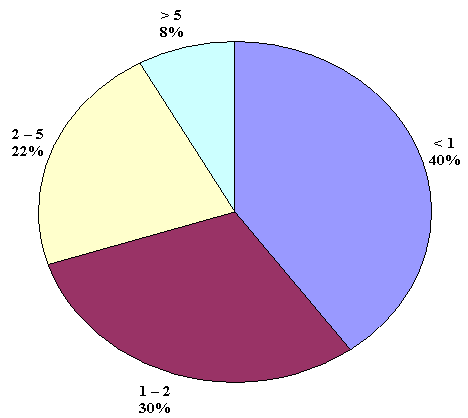 | Figure 2. Identification of working period of the employees of the big bazaar |
It was observed that the more than 60% employee’s, who were part of the survey, has been working in the Big Bazaar’s for more than one year. It can be observed from Figure 2 that 40% of employees were new appointed and have been working in the organization for less than one year, 30% employees have been working therein for 1 to 2 years, 22% employees have worked for more than 2 years but less than 5 yrs and the remaining 8% employees have been working for the period longer than 5 years. | Figure 3. Identification of strength of talent management program |
(ii). Strength and weakness of the talent management program: Figure 3 summarizes the strength and weakness of the talent management programs being applied in the Big Bazaar. It can be observed the large number of participants (about 80%) agreed with the implementation of the talent management program and its positivity in the strength development of the employees. It also suggests that the talent management program, in general, helps us to determine the weakness or strength of the employees. About 40% of the participant employees strongly agreed with the talent management program at the same time 40% agreed with it. 12% of participated employees responded in a neutral way that they are not clear about the positive side of the talent management program and whether it can really helps them to identify the strength and weakness of the employees. On the other hand, small number of participants (about 6%) did not agree with the concept of talent management program whereas negligible number of participants (2%) were strongly disagree with the scope of the program in indentifying the strength and weakness of the employees. | Figure 4. Influence of talent management program on the strategic changes in the organization |
(iii). Influence of the talent management on the strategic changes in the organization: An analysis of Figure 4 suggests that largest number (44%) of participated employees experienced an improvement in the management and employees relationship due to the talent management program. Almost equal but little less number (36%) of participants were in agreement with the change in the motivational strategic (both monetary and non-monetary) which helps for the development of the employees and as well as for the organization. All these affects were due to the proper implementation of the program. The above two responses in terms of the management and employees relationship and strategic development of employees and organization were clearly due to the employees who have spent longer work period in the Big Bazaar. Restructuring of organization or individual elements in the organization due to the talent management have also been experienced by about 8% of the respondent. The 6% of the respondent agreed with the possible changes in the area’s of dissatisfaction of employees of the organization. The remaining 6% of the participants were in in-line with the talent management and responded that no decision making is possible due to the bound to the limitations or shortcomings of talent management program. | Figure 5. Usefulness of talent management program in the employee’s performance |
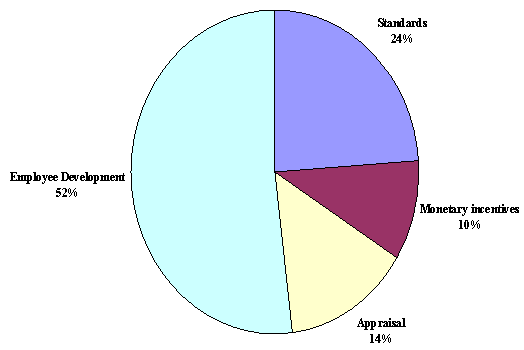 | Figure 6. Importance of the talent management in the improvement of particular areas |
(iv). Usefulness of the talent management in the employee’s performance: It can be observed from Figure 5 that the responses in relation to the usefulness of the program in the performance of the employees are also in accordance with the response to previous items of the questionnaire. In general, above 50% of the participated employees agreed with the role of talent management program and its usefulness in the enhancement of their performance. 15% of the participants were in strong agreement that the talent management program is most important to develop their performance. However, 39% of the participants responded that talent management plays a very important role in enhancing their performance. On the other hand, about 42% of the employees did not agree and responded that talent management is less important in this aspect whereas 4% suggested that talent management is not at all important in their performance. (v) Importance of the talent management in the improvement of particular areas: It can be observed from Figure 6 that most of the respondent felt that the talent management program can bring improvements in one or another area of employees or organizational interests. For instance, about 24% of the participants responded about the standard improvements, in general whereas large number of participants (52%) were in agreement with the employees overall development due to the talent management practices. Small number (10%) of participants also responded that talent management helps them in terms of the monetary incentives; however, 14% employees were looking forward about the appraisal gains due to the talent management. All in all, most of the participants were possible in one or other way of the improvements in the employees results due to the talent management program. (vi). Effectiveness of the talent management on the employee’s potential advancement: Figure 7 represents the effectiveness of the talent management on the employee’s potential development. The response was obtained in four levels, i.e., highly effective, effective, neutral or ineffective. It is seen from the figure that the large population responded in the positive manner, i.e., about 28% of the employees felt that the talent management programs adopted by the big bazaar are highly effective for their potential advancement. Along the same line, about 40% of employees are in agreement of effectiveness of such programs. Over all, about 68% of the respondents were positive about the effectiveness in the employee’s potential development. Like all other surveys, about 24% of the respondent were neutral in their response, however, very small fraction (8%) of the participants were not at all in the agreement with the effectiveness of the talent management program in their potential advancements.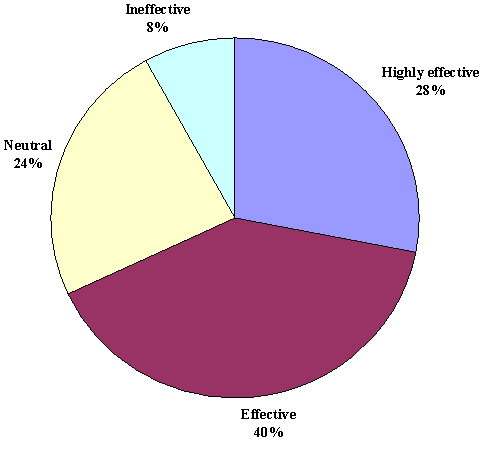 | Figure 7. Effectiveness of the talent management on the employee’s potential advancement |
(vii). Identification of employee’s motivating factor towards the work environment: Figure 8 identifies the motivating scale of the talent management on the employee’s work environment. Similar to the previous discussions, here also, it can be seen that about 28% of the participants were highly motivated and about 52% of the employees were fairly motivated towards their work environment which was due to the proper implementation of talent management practices. The survey suggests that small number of participants (about 16%) remained neutral, however, 4% of the participants were negative in terms of the motivating factor. (viii). Co-operation and team work due to the talent management program: Figure 9 identifies whether the talent management program helps to win co-operation and team work among the employees of the organization. The response of the participants in this regards was fairly positive. For instance, 38% of the participants felt that the talent management program helps them very frequently, on the other hand, 32% responded that its helps them occasionally to easily cooperate and team work. Almost equal number of participants felt that they rarely (17% participants) or never (13% participants) get any positive help in winning up cooperation and team work. Overall, there is also win-win situation of talent management program.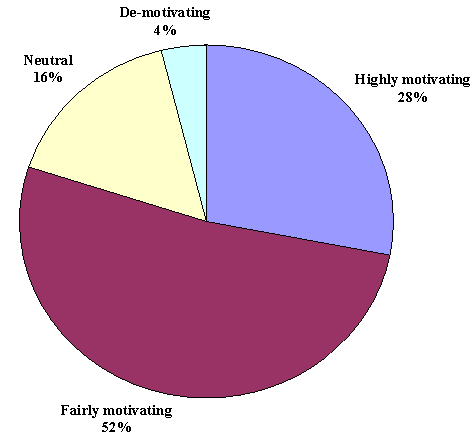 | Figure 8. Identification of employees motivating factor towards their work environment |
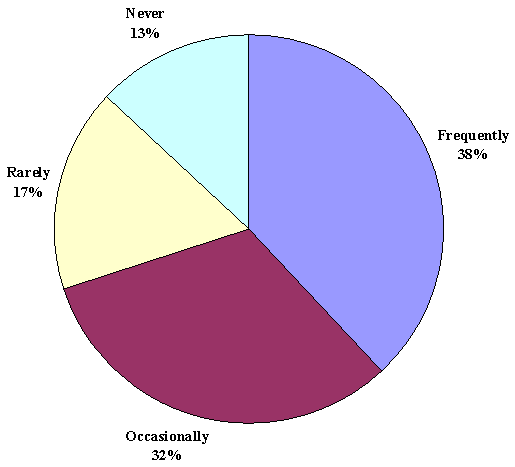 | Figure 9. Co-operation and team work due to talent management program |
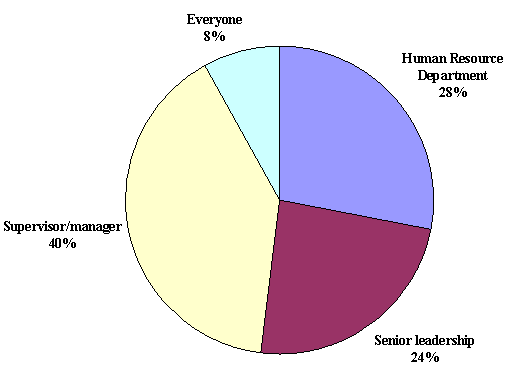 | Figure 10. Responsibility for talent management program and employees engagement in the organization |
(ix). Responsibility for talent management program and its employee engagement in the organization: The study also explored whether the participants understand that who is responsible for the talent management and its employee’s engagement in the organization. In the survey (Figure 10), about 28% of the participants replied that human resources department is responsible for such type of the activities with the organization. Almost equal number of participants (i.e., 24%) thought that senior leadership of the organization has to take care of this responsibility. The large number of participants (about 40%) replied that the supervisors and managers are responsible in proper implementation of talent management program and its employee’s engagement in the organization. However, very small fraction (about 8%) of the employees think that each and every individuals working for the organization has to take the responsibility of proper and successful practices of the talent management.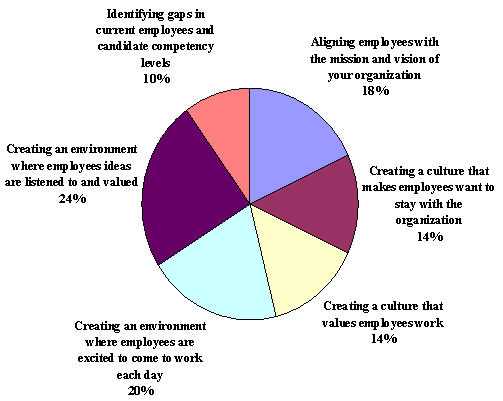 | Figure 11. Suggestion to improve the talent management program of the big bazaar |
(x). Suggestions to improve the talent management program in the big bazaar: Finally, the suggestions are also collected through the survey to improve the talent management program in the big bazaar. Figure 11 summaries the fraction of various suggestions asked in questionnaire. It can be seen that the largest number of employees (24%) suggested that the organization should create an environment where the employee’s ideas are listed and valued in the proper way. It is also suggested by 20% of the employees that the organization should create an environment where employees are excited to come to work each day. About 18% of the participants said that the organization should align their employees with the mission and vision layouts. Equal number of participants (14%) suggested that organization should create a culture which makes employees to stay with organization and also the employees work should be valued in appropriate manner. About 10% of the participants suggested identifying the gaps in current employees and candidate competence levels. Over all, the suggestions are very much appreciated by the author.
7. Summary of the Observations
From the analysis shown in the previous section, it was found that almost all of the respondents are satisfied with the result of the talent management program. Almost all the employees agreed that the talent management program creating a good work culture as well as enhances the values of employees and decrease in turnover of employees. Final observations of the study are as follow:● Training room, education, mentoring and coaching are usually used by the organization to carry out talent development activities● Most the employees have a clear knowledge about the company’s vision, mission and objectives. And they know how to achieve these objectives.● Employees are clear about their role and responsibilities.● Almost all of the respondents are satisfied with the result of the talent management program (changes in the organisation).● Almost all the employees are agreed that due talent management program, creating a good work culture as well as increase the values of employees, decrease in turnover of employees. ● Most of the employees are satisfied that talent management program helps to identify the strength and weakness of employees.● Improvement in personal skills of employees, employee’s relationship in the organisation.
8. Concluding Remarks
As organizations continue to pursue high performance and improved results through talent management program, they are taking a holistic approach to talent management – from attracting and selecting wisely, to retaining and developing personal skills of employees, to increase the confidence of employers, to placing employees in positions of greatest impact. Therefore, every organization want to grow and improve their systems and processes, so Big Bazaar must focus on the employee’s performance and potential or employees practices the allow or foster that growth and improvement through known best practices of the talent management program. The key variables (leadership competencies, experience, personal skill, employee’s interest, and rewards) that motivate employees to succeed have been identified and successfully put into practice. It is a viable path toward improving organizational performance
9. Recommendations
Based on the analysis conducted in the organization, the following recommendations are made to the organization:● As some of the employees are not agreed with results of the talent management program and talent management program is very important for developing the employee’s skills, so the organization has to take some more steps to improve the job environment and working conditions.● Some of employees get de-motivated with the result of talent management program, so organization should undertake those activities so that employees should get motivated. ● Divisional manager of the organization should create the full confidence in the agents/employees of the organization.● Sometimes quite difficult to identify the talent of number of employees in the organization, so divisional manager/supervisor of that organization should divide the employees/agents into the groups so that they can easily identify exact talent of the employees.● Manager should undertake interesting activities so that hidden talent of employees can be improved.● The relationship b/w agents/employees and manager with in the organization should be clear, so that agents can easily transfer the employees problems to manager without hesitation.
Annexure
Questionnaire for Talent Management Program of Employees of Big Bazaar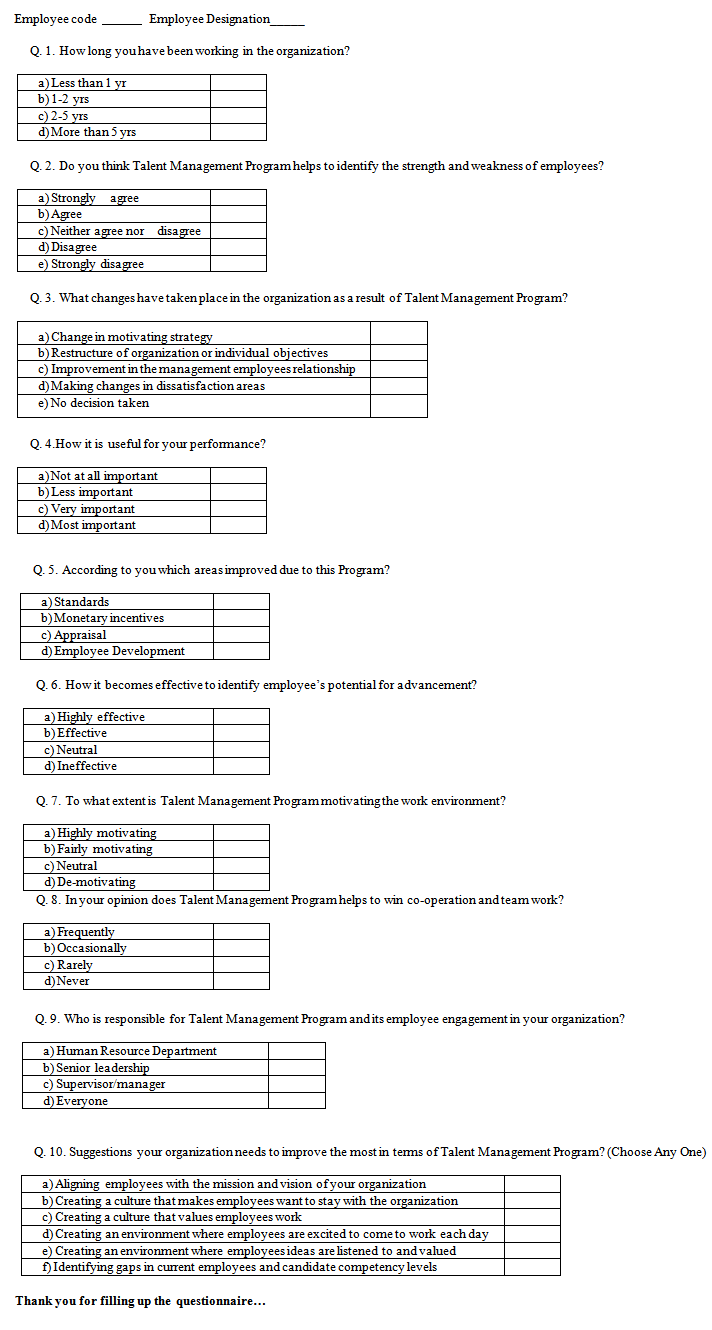
References
| [1] | Uba C. (2011). Talent management strategy. Business World Intelligence.http://businessworldng.com/web/articles/1739/1/Talent-Management-Strategy/ |
| [2] | Bryan, L., Joyce, C. and Weiss, L. (2006). Making a market in talent. McKinsey Quarterly, 2. |
| [3] | Key C. Talent management helps supermarket chain live brand promise.http://www.cornerstoneondemand.com/talent-management-helps-supermarket-chain-live-brand-promise |
| [4] | Talent management concept - definition and explanation. http://derekstockley.com.au/newsletters-05/020-talent-management.html |
| [5] | Lockwood N.R. (2006). Talent management: driver for organizational success. SHRM Research Quarterly. |
| [6] | Pasmore, W. (2011). Developing a leadership strategy: a critical ingredient for organization success. A white paper by Center for Creative Leadership, 28 pages. |
| [7] | Industrial Relations Counselors, Inc. (2004). IRC survey of global talent management practices. |
| [8] | Industrial Relations Counselors, Inc. (2009). An executive summary on “Talent management processes for a diverse leadership team”. A study conducted by ORC Worldwide Global Equality, Diversity and Inclusion Practices for IRC, Inc. |
| [9] | Lewis R.E. and Heckman R.J. (2006). Talent management: a critical review. Human Resource Management Review 16(2) 139 – 154. |
| [10] | Goldsmith M. and Carter L. (2009). Best Practices in Talent Management: How the World's Leading Corporations Manage, Develop, and Retain Top Talent (Pfeiffer Essential Resources for Training and HR Professionals). Pfeiffer Publications. |
| [11] | Berger L. and Berger D. (2010). The Talent Management Handbook: Creating a Sustainable Competitive Advantage by Selecting, Developing, and Promoting the Best People, 2nd edition. McGraw-Hill |
| [12] | Effron M. and Ort M. (2010). One Page Talent Management: Eliminating Complexity, Adding Value. Harvard Business Review Press |
| [13] | McDonnel A., Lamare R., Gunnigle P. And Lavelle J. (2010). Developing tomorrow's leaders—evidence of global talent management in multinational enterprises. Journal of World Business 45 (2) 150 – 160. |
| [14] | Gopal R. and Vij P. (2011) Talent management in IT industry. UGAM Research Journal, 3 - 12. |
| [15] | Piansoongenern O., Anurit P. and Kuiyawattananonta S. (2011). Talent management in Thai cement companies: a study of strategies and factors influencing employees engagement. African Journal of Business Management 5(5), 1578 – 1583. |













 Abstract
Abstract Reference
Reference Full-Text PDF
Full-Text PDF Full-text HTML
Full-text HTML